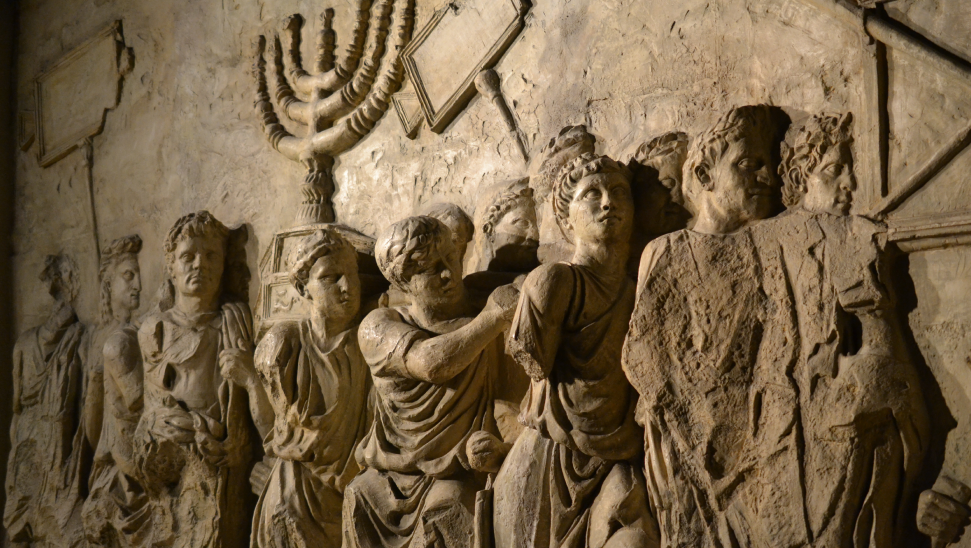
The history of Antisemitism 1: From Antiquity to the Enlightenment
The term antisemitism literally means hostile feelings about Jews. However, the concept is not that simple as it has taken on different guises in different cultures and eras, for different reasons, while several features have been passed on from one period to the next. Another striking feature of antisemitism through history is that it is much more descriptive about antisemites and the processes in mainstream society than about the Jews themselves. This chapter aims to provide a short summary of the appearance of antisemitism in the various historic periods and show how it was handed down in a new shape each time and still retaining one or another specific feature.
Antiquity
The hatred of the Jews of the 18th century or the pre-modern era, is more properly called anti-Judaism, referring to its mainly religious character. After all, race theory, however pseudo-scientific it was, had not yet developed in the anthropological and biological sense, and the discrimination of the Jews, which often meant their persecution as well, concerned a group that was religiously separated from the majority society. The term judeophobia is apt when describing the prejudice of the ancient Greeks towards the Jews, because it is more a cultural, philosophical, and tradition-related antagonism, where religion only plays a small part.
The monotheistic Jewish religion, with its strict rules regulating the tiniest details of everyday life, was very different from the polytheistic faiths of antiquity. Regardless of religious differences, the persecution of the Jews was often due to the fact that their kingdom was located in the buffer zone of great empires, in areas that Assyria or the New Babylonian Empire wanted to conquer. It is consequently all the more understandable that monotheism, the several hundred years of traditions and the uncompromising religious, dietary and dress codes were mighty identity-forming forces for the Jews, even after antiquity. Over the centuries, the Jewish people have had to suffer the agonies of expulsion, dispersion, and captivity, yet they have always been able to return to their roots.
In the empire of Alexander the Great and his successors, in the Hellenistic world, and in the otherwise religiously tolerant Roman Empire, a great number of conflicts arose between the rulers and the conquered Jewish people, based on both religion and politics. IV. Antiochus Epiphanes expected his subjects to worship him in a way that was forbidden to the Jews, and the Romans also repeatedly insulted the Jewish religion, either on purpose or out of ignorance. This led to a series of riots, which finally resulted in a total expulsion: the Jews were not allowed to remain in Iudea and Jerusalem after the end of the 1st century AD and were forced to complete diaspora.
In addition, some considered the Jews a competition or were bothered by their proselytism; starting from the 6th century B.C. several Jewish communities arose in the larger cities of the Old Persian Empire, then in the hellenistic successor states and later in the area of the Roman Empire (e.g. in Alexandria, Egypt). It meant that the Jews often voluntarily abandoned their former geographical boundaries. It was the time when the rumors of the unfounded stereotypes of secret cults and human sacrifices began to appear, which, of course, were strongly forbidden in the Jewish religion.
Christianity appeared in the 1st century A.D. and started to spread quickly. Although both religions were monotheistic and therefore refused to recognise the emperor’s divinity, Christianity faced severe persecution until the early 4th century, while Judaism, although forced into diaspora, was free to practice its religion. The difference in treatment is probably due to the fact that the Christian religion spread throughout the empire, among all social and ethnic groups, while Judaism remained within the Jewish community – conversion and mixed marriages being quite rare – and therefore did not pose as much of a threat to the established social and power order in the eyes of the empire. It was the Christians who were accused of secret, and therefore suspicious rituals, where children were sacrificed, and their blood was drunk. However, Jews were restricted and punished by a good number of laws, so they were not accepted at all.
It is paradoxical that when Christianity became an accepted religion in the 4th century after onstantine’s conversion, and a state religion by the end of the century, the same accusations, especially the blood libels were directed at the Jews. Despite having the same roots, the two faiths are irreconcilable on the most important issue: according to Christianity, Jesus Christ is divine as the Son of God, while the Jews still await their Messiah. (The young Catholic Church was also intolerant towards other Christian tendencies, i.e. the heresies.) In addition to the Judeophobic tropes from the ancient Greece, the Church Fathers, from Tertullian, active in the 2nd and 3rd centuries AD, to St Augustine, also gave grounds to the accusations against the Jews in their writings. They focus, for example, on the argument that the Jews lost their right to being the ‘chosen people’ when they killed Jesus, thus collectively condemning the contemporary Jews and their generations to come as guilty. What makes this really interesting is that these anti-Jewish tropes have persisted and continued to live on even in the 21st century, when hatred against Jews is no longer based on religion.
Middle ages
Christianity was the dominant religion in medieval Europe, and this determined the position of the Jews. Ecclesiastical and secular legislation had not yet become distinct, but the synodal decrees give an almost accurate picture of the position of Jews in society. Christian and Jewish communities were visibly separated geographically on the one hand; dating back to antiquity, medieval cities were characterized by different occupational, religious, and ethnic groups living in their own neighborhoods. Several cities had separate Greek, Syrian, Jewish etc. quarters. A neighborhood of their own was also a religious requirement to some extent for the Jews since one is not allowed to go more than a few steps away from the synagogue on Shabbat. Their quarters were not necessarily forced settlements, but in 16th-century Venice, for example, where the word ‘ghetto’ was said to be coined, a law designated a guarded and enclosed area for Jews to live in; whether for isolation or protection is difficult to say. In any case, the segregated Jewish quarter provided an opportunity for the majority society to view a group of people of a different religion with suspicion, having no insight into their lives. The synagogue and the surrounding houses provided an easy target, when an angry mob, their fury whipped up as if hypnotized, attacked Jews on Easter, blaming them for killing Jesus.
At certain points in history Jews were required to wear distinctive signs, which made them even more of a target. For example, the 1215 Fourth Council of the Lateran required them to wear yellow or blue ribbons. On the other hand, segregation was also exercised socially, and this was ensured by legislation. A whole range of prohibitions applied to the Jews. They were banned from several occupations (public office, certain crafts, guild membership), as well as from intermarriage. The one with the most serious consequences was clearly the ban on Jews becoming landowners or land users. This greatly reduced opportunities for the Jews, as they could neither become members of the nobility nor of the serfs, and only certain crafts and trades, commercial and possibly ‘medical’ careers were open to them, i.e. the jobs of the townspeople. These occupations were, of course, not foreign from the Jewish culture, since starting with the antiquity, diaspora meant urban settlement, and unlike in the Christian Europe, education of the (male) children and the study of the Torah and Talmud were prominent parts of Jewish family values.
The European economy in the late Middle Ages had already relied on well-developed financial services, especially in northern Italy and in the Low Countries; the lively trade and the occasional Verlag system activities required bank loans and credits. However, the Roman Catholic Church forbade levying interests and the practice of usury, which was therefore practiced by groups not subject to the punishment of excommunication: Ishmaelites, i.e. Muslims, Orthodox Greeks, and Jews. Their activities were therefore necessary, but when a debtor (especially when it was a ruler) could not pay, the hate card could always be played. In Spain, countless pogroms and persecutions were generated by such conflicts. Such persecutions mostly afflicted Jewish bankers and the Jewish community, even those who had nothing to do with finance, probably because they had the prejudices ready: blood libels, the accusation for the murder of Christ, and for well poisoning, especially in times of epidemics, were always at hand. However, because, as mentioned above, a range of other occupations were closed to them, Jewish people were caught in a vicious circle: they
were forced into occupations that were necessary to society, but which created new prejudices against them.
In the context of the Middle Ages, the Crusades must also be mentioned contributing to and strengthening existing prejudices and anti-Jewish sentiments. Most Crusaders did not sign up for the campaign out of religious motivation, and atrocities were known to have been committed before they reached the Holy Land, and not only against Muslim inhabitants. The crusaders’ journey was marked by pogroms, synagogue and Torah burnings and massacres, and not just in the Holy Land. The Jewish inhabitants had to suffer brutal persecution in Western Europe in particular, especially on the Iberian Peninsula. Starting with 1391, they were subjected to forced baptisms, in the kingdoms of the Iberian Peninsula (in parallel with the Reconquista), Jewish people were subjected to forced baptism, and those who resisted were exiled to Portugal, having to flee further afield in the following centuries, for example to Amsterdam. Part of the so-called Sephardic Jewry living in the Mediterranean basin fled to Eastern Europe, where the Ashkenazi Jews had been living. Many of the converted Jews kept their old traditions, their religion in their hearts (the so-called Marranos or Conversos), which of course gave rise to new suspicions. While baptism was supposed to have made man an equal member of the Christian society, here the theory has emerged that the (unfounded) characteristics considered to be descriptive of the Jews were inherited through blood, thus anticipating the racial theories of later ages.
Reformation
The Reformation in the 16th century brought no real improvement in the acceptance of Jews. Although the Protestants were keen to go back to the Old Testament roots of Christianity, for example in forbidding the depiction of man in churches, as in Judaism, or in recognising only the Holy Scriptures as divine revelation (sola Scriptura), the Christological controversy of whether Christ is the Son of God or not continued, of course. They considered the only solution for Jews to convert to Christianity, otherwise Jews would face the same persecution in Protestant areas as in the German principalities. Anti-Jewish tropes lived on in popular beliefs as well as in theological writings: towards the end of his life, Martin Luther’s hatred of the Jews became even more extreme. Initially, he was ready to accept that the much-condemned usury had ultimately been imposed on the Jews by Christian society, squeezing them out of all other areas, but eventually, his angry impulses got the better of him, so much so that in his 1534 work he practically recommended the killing of the Jews. Given Luther’s great influence on German thought, especially in the northern regions, we must consider his role in the development of German antisemitism.
This is a shortened abstract from our Deliverable D3.1 “Educational curriculum and training materials for youth”, which you can also find on the BOND website!



Leave a Reply
You must be logged in to post a comment.